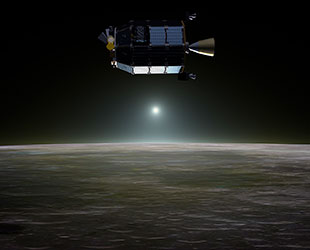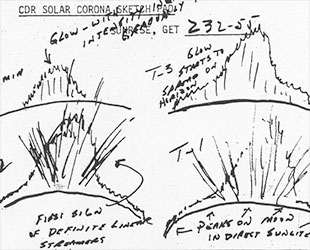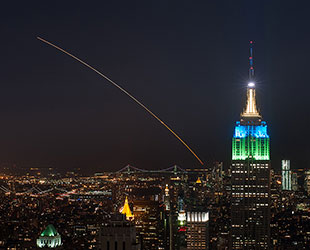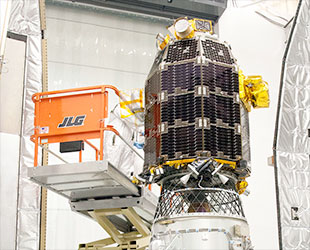September 6, 2013 — NASA's first moon-bound probe to launch from Virginia lifted off late Friday evening (Sept. 6) on the maiden flight of a new five-stage rocket.
The Lunar Atmosphere and Dust Environment Explorer, or LADEE (pronounced "laddie") soared space-ward at 11:27 p.m. EDT (0327 GMT Sept. 7) riding atop
Orbital Sciences Corp.'s new Minotaur V booster, a converted Peacekeeper missile, from the Mid-Atlantic Regional Spaceport Pad 0B at NASA's Wallops Flight Facility on Wallops Island, Va.
The $280 million LADEE mission will use a trio of science instruments to study the moon's exosphere, the very thin layer of atmosphere just above the lunar surface, and the effects that environment may have on moon dust.
"I think sometimes we get a little surprised when we start talking about a lunar atmosphere because most of us were taught in school that the moon does not actually have an atmosphere," said Sarah Noble, LADEE program scientist at NASA Headquarters. "It does, but it is very, very thin."
"It's so thin that the individual molecules that make up the atmosphere never see each other, they don't ever interact, they don't collide," she added.

Artist's rendition of the Lunar Atmosphere and Dust Environment Explorer (LADEE) in orbit above the moon as dust scatters light during the lunar sunset. (NASA Ames/Dana Berry) |
A better understanding of the moon's exosphere may help explain a mysterious "moon glow" first observed by Apollo astronauts and
early robotic lunar landers, as well provide insight into the atmospheres that surround other planetary bodies in our solar system.
"Mercury, a lot of the moons of the outer planets, as well as some of the larger asteroids in our solar system have surface-boundary exospheres," Noble said. "It turns out to be the most common class of atmosphere we have, and yet it is one that we don't know very much about."
D is for dust
"The 'D' in LADEE stands for dust," Noble said. "Our other major objective is to understand the dust environment."
The Apollo astronauts who explored the moon in the late 1960s and early 1970s found that its surface was covered with a fine layer of dust that was made from crushed lunar rocks. This powdery dust was the end result of billions of years of meteor impacts, which also produced the moon's cratered surface.

Sketch of lunar sunrise as seen from orbit by Apollo 17 astronaut Eugene Cernan showing 'streamers' in the exosphere. (NASA) |
Since even before the
first "small step," scientists have suggested it was possible for the moon dust to sometimes go "airborne," the result of the build up of electric charges where the "day" and "night" sides of the moon meet.
These suspected dust "clouds" may be responsible for an observed glow over the lunar surface.
"The Surveyor [7] spacecraft saw a strange thing on the horizon, just before sunrise," Noble described. "This sort of glow, and we think it might be due to dust getting lofted into the atmosphere and reflecting the light."
"The Apollo astronauts also saw this horizon glow. Apollo 17
astronaut Gene Cernan not only saw this horizon glow, he saw these things he called 'streamers' going up high into the atmosphere – tens of kilometers – which we also think is due to the dust," she said.
LADEE will help unravel this Apollo mystery by measuring the extent to which dust is lofted into the lunar exosphere.
LADEE's lasers
LADEE will take about a month to reach the moon, circling the Earth three times as its Minotaur upper stage boosts the 844-pound (383-kilogram) spacecraft high enough to be captured by the moon's gravity.

The launch of NASA's Lunar Atmosphere and Dust Environment Explorer, as captured rising behind the Emipire State Buiding in New York City, Sept. 6, 2013. (LaunchPhotography.com/B. Cooper) |
Once in lunar orbit, the probe will enter a checkout period of about a month and a half, during which time its altitude above the moon will be lowered and testing will commence with an innovative communications system.
Currently, communications with spacecraft beyond close-
Earth orbits require spacecraft to have small, low-mass, low-power radio transmitters and giant satellite dishes on Earth to receive their messages. The LADEE spacecraft's Lunar Laser Communications Demonstration (LLCD) uses lasers, instead of radio waves, to obtain broadband speed communications with Earth.
LADEE will spend 100 days studying the lunar exosphere, scooping up traces of the moon dust and measuring the composition of the lunar atmosphere. As its maneuvering fuel nears depletion, LADEE will be allowed to de-orbit and impact the moon.

Engineers encapsule the LADEE spacecraft into the fairing of the Minotaur V launch vehicle nose-cone. (NASA WFF/Terry Zaperach) |
LADEE is the first spacecraft to be developed, designed, integrated and tested at NASA's Ames Research Center in California. The probe is also the first to use the Modular Common Spacecraft Bus architecture, aimed at drastically reducing the cost of spacecraft development. 